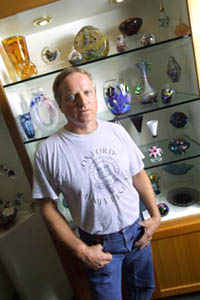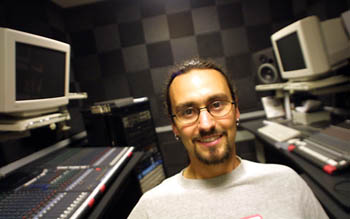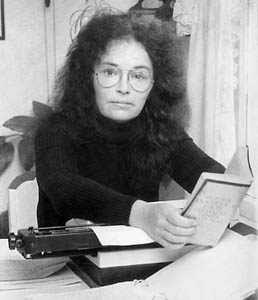![[MetroActive News&Issues]](/gifs/news468.gif)
[ Santa Cruz Week | MetroActive Central | Archives ]
Photograph by George Sakkestad
The Paradise Express
Rising rents and shrinking spaces are causing many artists to leave Santa Cruz. Does their departure signal the beginning of a cultural exodus?
By Julia Chiapella
PARADISE IS ABOUT 20 MILES east of Chico. Nestled in the Sierra Nevada foothills, the town can get hot as Hades in the summer and downright freezing in the winter. Known as "the Ridge" to locals, this bedroom community to Chico's university town is rapidly gaining popularity as one of California's last affordable places.
Why is this blip of a burg the least bit significant? Because at a recent Paradise party for visual artist Victoria Sulski--formerly of Santa Cruz and now a Paradise resident--those in attendance made a startling discovery. "We got to talking," said artist Trudi Eldridge, herself a former Santa Cruz resident, "and realized there were eight of us there who used to live in Santa Cruz."
It would seem Paradise is calling.
Among those at the party was writer Claire Braz-Valentine, who recently sold her mobile home in Capitola. For half the price of the mobile home, Braz Valentine purchased a two-bedroom house on a third of an acre in Paradise. Santa Cruz, she says, is a beautiful place and she's given it "30 years of my life." But despite her affection for the area and its people, Braz-Valentine has concerns about the changes that she sees taking place here.
"What kind of place are we living in," she asks incredulously, "when young people can't survive here?"
This is no news flash. Young people and those working in the service industries--nurses, teachers and auto mechanics--are finding it increasingly difficult to make ends meet in this tight housing market. But the local economic situation is affecting another group of Santa Cruz residents: its artists. Many of them are leaving; some just want a change. Many--like screenwriter/author Dan Bessie, who left Santa Cruz for the more affordable Sierra foothills--credit the astronomical rents and housing prices as the reason. Others point to a shift in values that may have been the result of the influx of new money--specifically the rise of the dotcom industry and the spread of Silicon Valley toward the ocean. And while we're seeing this boon suffering the inevitable throes of a too-much too-fast syndrome, the downward spiral has had a negligible effect on the housing market. And to top it all off, there's the traffic, a bumper to bumper miasma that has even the most gentle souls gnashing their teeth.
While these artists have fond feelings for Santa Cruz, they can all agree on one thing: Santa Cruz is in danger of becoming paradise lost.
Exit, Stage Left: UCSC theater technician Nick Farwell has had enough of Santa Cruz's outrageous rents; he's relocating to Seattle.
Pay to Play
'IT'S NOT the small town it used to be," says Steve Lundberg, a successful glass artist whose work is featured in the Smithsonian as well as in galleries around the country. He's one of the nation's premier glass artists, having paved the way for other glass artists as well as guaranteeing his own success. He doesn't have a problem making ends meet in Santa Cruz.
But Lundberg is leaving the area next year for Ashland, Oregon. After three decades in Santa Cruz, he says he wants a simpler life. He could continue to work at breakneck speed and fund his high cost of living in Santa Cruz or he can slow down and make more time for family, more time to explore his creative ideas, more time to play. His decision was also prompted by the fact that two of his employees left the area because they couldn't afford to buy houses here.
"I've been here 30 years," Lundberg says. "I've seen Santa Cruz change enormously."
Lundberg is excited about the move to Ashland, citing a shift of scenery as always beneficial to an artist's work. It will stir up new ideas, open new avenues. He's also taking some of his employees with him, including his son and his son's family. In Ashland, Lundberg says, his son will be able to afford to buy a home.
While the draw to make good on the American Dream is what's pulling several artists away from Santa Cruz, others are having problems just finding a place to rent.
Nick Farwell is a theater technician at UCSC, but he's relocating to Seattle, Washington. While he's following his girlfriend to the area, he says he's glad to be leaving.
"I have friends who couch-surfed for months before they found a place to live," Farwell says. He adds that many UCSC students have horror stories about their housing searches.
According to RealFacts, a Novato database company that tracks investment-grade apartment complexes in the Western United States, the occupancy rate for Santa Cruz County for the quarter ending March 31, 2001, was 97 percent. "That's down from the high of 98.5 percent in the third quarter of 2000," says Gerald Cox, spokesperson for RealFacts, "but still running pretty full."
Six months ago the Tri-County Apartment Association, a trade organization for landlords who own rental property in Santa Cruz, Santa Clara and San Mateo counties, conducted a survey of its members to determine availability of rentals. The numbers would make anyone looking for a rental weep: availability was running one unit out of 100. Natalie Cardenas, government relations manager for the agency, said the units that were coming up were being rented on a 30-day basis. "There wasn't enough housing to go around," she says. Those numbers have since softened but Cardenas believes the housing market will "stay strong"--for landlords, that is.
Farwell says things were different when he first came to Santa Cruz in the early '90s. Then, finding an inexpensive place to live was easy. Now, he says, the housing climate is far from friendly. So, Farwell is saying farewell to Santa Cruz.
Control Group
ARTISTS, NOT SURPRISINGLY, are quick to brainstorm creative solutions for the housing problem: Braz-Valentine suggests subsidized housing for artists; Farwell raises the always-controversial issue of rent control.
The Tri-County Apartment Association is of the opinion that rent control just makes the situation worse.
"[Rent control] only helps a very small number of people for a very small period of time," Cardenas says. "People hoard the units. Tenants live in their rentals for years and years."
Former Santa Cruz mayor and long-time rent control advocate Mike Rotkin says this doesn't wash.
"The rental market is out of control and anything you could do to affect it in a positive manner is worth the effort," says Rotkin, now a lecturer in community studies at UCSC. Even reasonable landlords, says Rotkin, will charge what the market will bear and "that's too much for people, like artists, with little money to spend."
The sidebar to most of the suggestions, however, is that art and artists are continually relegated to second-class status. If we didn't have a collective attitude that deems art a frivolous way to make a living, we'd make sure our artists found a way to live here.
"It's devastating that you can't attract and keep people here," laments Buff McKinley, program coordinator for the Cultural Council of Santa Cruz County, which grants awards to arts organizations and sponsors several arts programs and events, including the annual Open Studios tour. McKinley says "how to afford to live in Santa Cruz" is an ongoing topic of discussion at the Cultural Council and acknowledges that several well-known artists, including photographer and Cabrillo College instructor Gypsy Ray, have left the area for less expensive climes. "Profound sadness is the only way to look at it," she says.
That outlook springs from a deeply held belief that art is a basic requirement for a community's health. Without the ability to explore, to question, to imagine and to create, a community loses touch with its own humanity.
Modern Medicis
EVEN IF SANTA CRUZ were to address the problem by pursuing subsidized living space for artists, the road there would be a long one. Mary James, executive director for the County Housing Authority, says artists have the same access to subsidized housing as others in low-income brackets but that public money specifically for artists' housing "isn't targetable," a notion that's debatable.
As an immediate solution, subsidized housing would have to come from the private sector and any artist can tell you what that means: patronage. In recent history that patronage has come from foundations like the William and Flora Packard Foundation. With the increase in wealth among those in the tech industry, several artists mentioned in conjunction with this article talked about that group's responsibility in supporting the arts.
Philippe Kahn, the founder of Borland, Starfish Software and now LightSurf, is one of Santa Cruz's most notable high-tech entrepreneurs. Kahn has recently created the Lee-Kahn Foundation, which sponsors "local and national nonprofit organizations dedicated to advancing human growth through increased access to education, health care and the arts." He also donated $15,000 to the 418 Project, a Santa Cruz dance and performance space‚ to get it up and running. Kahn believes it's important for successful companies to support their communities.
"We certainly encourage all the high-technology companies that we are involved with to participate in our community's nonprofit causes," Kahn says. "Not just art, but education, safety and law enforcement, health and environmental issues. They all should have an important place in our lives when we are privileged enough to have good health and reasonable financial resources."
It's a laudable attitude, but thus far, the tech companies aren't exactly ponying up to make sure their communities are the cultural, well-educated and environmentally sound places Kahn wants to promote. According to Santa Cruz percussionist Rick Walker, the failure of tech companies to contribute to the arts is deplorable.
"We live in the wealthiest place on the face of the planet," Walker says. "You'd think that the arts would flourish but they aren't. In fact, they're doing worse. Shame on them."
Affording Artists
WALKER IS AMONG the many artists who are staying in Santa Cruz. Despite their decision not to leave, some of these artists are concerned about the changing landscape.
Dancer Tandy Beal and composer Jon Scoville came to the area in 1966, the heyday of the psychedelic revolution, and found Santa Cruz an open, socially aware community. The advent of the university created an atmosphere of "infinite possibility" that encouraged experimentation and was unabashedly progressive--a perfect climate for growing artists.
"If I have nostalgia for anything," says Scoville of that era, "it's not for In-A-Gadda-Da-Vida but for a sense that there's more to life than earning money."
Now, say the couple who both teach to supplement their art, they see students graduating from college with loans to repay and rents that are astronomical.
Beal describes herself as action- and solution-oriented and throughout the discussion she seems determined to find an answer. She wants to figure out a way for artists to stay and she has plenty of ideas, from finding someone to bankroll housing for artists to setting up an organization that, much in the same way the Nature Conservancy buys land to preserve it, funds artists so they can continue their work. But many of these ideas require people who believe wholeheartedly in the necessity and significance of art, something we still seem to be short on.
Beal's longer-term solution is a sound one: get children involved in art. Let them see first-hand its transformative power, and you'll have lifelong arts advocates. In their hands, art will no longer be considered a frivolous luxury but an essential requirement for a prosperous, humane community.
Beal and Scoville have no desire to live anywhere but Santa Cruz and they were able to get into the housing market when it was still "cheap and seedy." They can afford a life here. This goes for many older, more established artists, but Scoville says that a community without younger artists suffers.
"Older artists need to have younger artists around to challenge their assumptions," Scoville says. "We'll all lose if they're not around and coming up with different answers to the same questions."
Walker and his wife, singer/songwriter Christine Wedertz, also have no plans to leave Santa Cruz. A few years ago Walker saw the upswing in the housing market and started looking elsewhere for an area to call home and maybe buy a house. But he didn't find anything like Santa Cruz, a community with enough diversity and musical opportunities to barely eke out a living, which is what Walker's doing.
"If I were starting today to be a professional musician there's no way I could do it," he says. "Things have changed so much."
There can be no question that Santa Cruz is changing. It's not the sleepy little coastal town it once was; it hasn't been for a long time. Whether the changes are due to the spread of Silicon Valley and its values, the lack of affordable housing or, as Scoville sees it, the outcome of advanced capitalism is open to fervent, continual debate.
And while the downturn in the economy has some hopeful that the cost of living might become more realistic, none of the individuals or organizations contacted had any evidence that artists were returning as a result of these changes.
To go or to stay? Artists will always find places to do their work. They'll always seek each other out. Whether Santa Cruz and its surrounding area can continue to viably support them remains to be seen.
Copyright © Metro Publishing Inc. Maintained by Boulevards New Media.
![]()
 Movers and Shakers: Santa Cruz has been good to glass artist Steve Lundberg, but he's looking forward to a simpler life in Ashland, Oregon.
Movers and Shakers: Santa Cruz has been good to glass artist Steve Lundberg, but he's looking forward to a simpler life in Ashland, Oregon.

Photograph by George Sakkestad
 Epilogue Jam: Writer Claire Braz-Valentine sold her Capitola mobile home and bought a two-bedroom house in Paradise, outside of Chico.
Epilogue Jam: Writer Claire Braz-Valentine sold her Capitola mobile home and bought a two-bedroom house in Paradise, outside of Chico.
From the July 18-25, 2001 issue of Metro Santa Cruz.